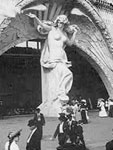Missouri State Capitol
The Missouri State Capitol Building's ground floor serves as the Missouri State Museum. As such, it offers two halls—one dedicated to state history and one to the state's natural resources. The three other floors of the 1924 structure are also open to the public. Noted artists who were involved in the building's creation include Frank Brangwyn, N.C. Wyeth, James Earle Fraser and Alexander Stirling Calder.
The museum offers exhibits and dioramas, while a 30-minute guided tour is available for the entirety of the building.
